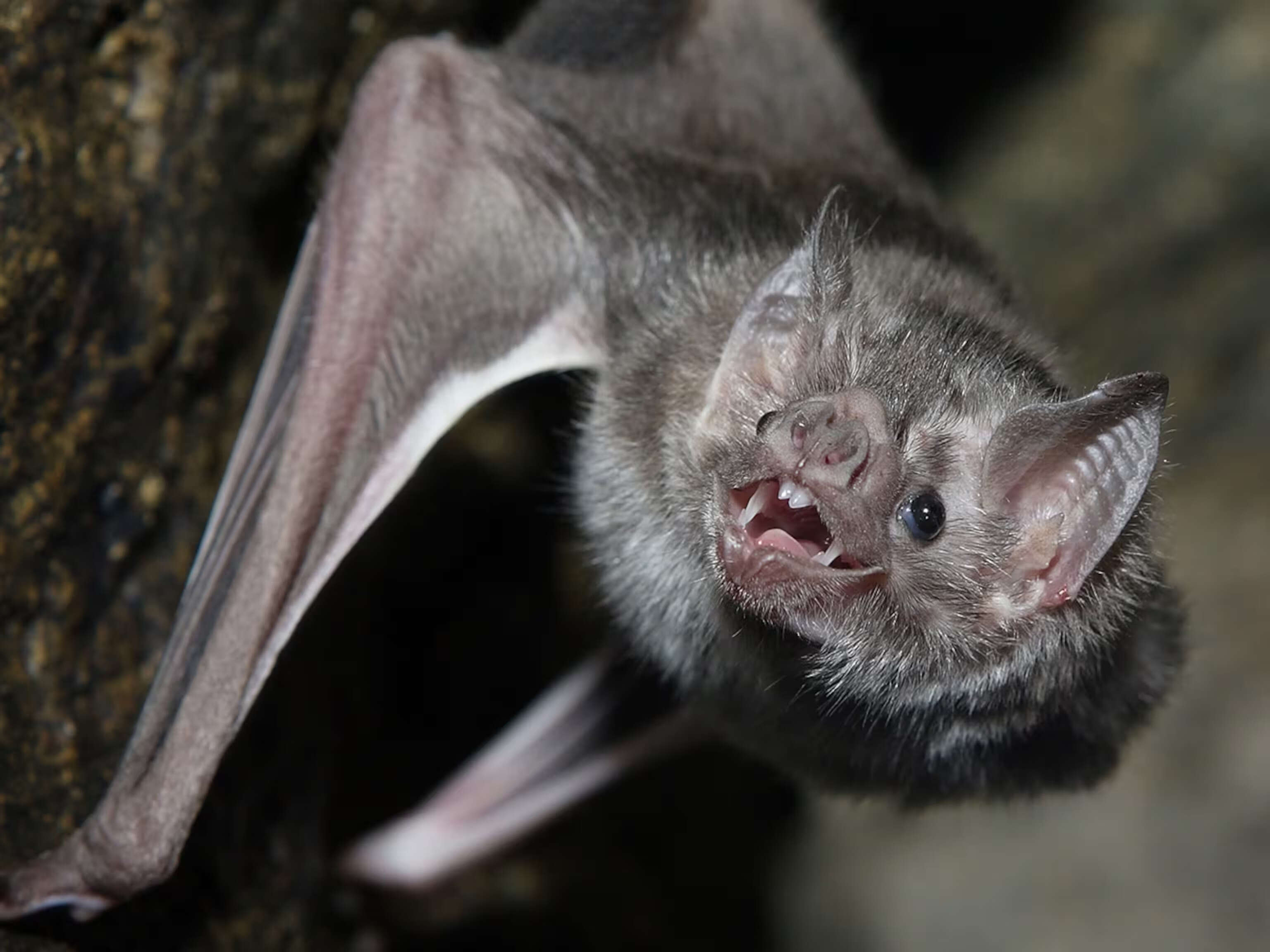
Vampire bats are some of the most intriguing creatures in the animal kingdom. Known for their blood-sucking habits, these nocturnal mammals have fascinated and frightened humans for centuries. But how much do you really know about them? Did you know that vampire bats can detect the sound of a breathing animal from over 100 meters away? Or that their saliva contains a special enzyme that prevents blood from clotting? These bats are not just spooky; they are also incredibly skilled hunters with unique adaptations. Let's dive into 35 fascinating facts about these mysterious creatures that will leave you both amazed and a little bit spooked!
Key Takeaways:
- Vampire bats are the only mammals that feed exclusively on blood, using heat sensors to locate blood vessels. They have unique adaptations, such as anticoagulant saliva and a highly developed sense of smell.
- Vampire bats have complex social behaviors, including sharing food with roost mates and using vocalizations to communicate. They play a crucial role in their ecosystems by controlling insect populations.
What Are Vampire Bats?
Vampire bats are fascinating creatures that have captured human imagination for centuries. These nocturnal mammals are known for their unique feeding habits and intriguing behaviors. Let's dive into some captivating facts about these mysterious animals.
-
Vampire bats are the only mammals that feed exclusively on blood, a diet known as hematophagy.
-
There are three species of vampire bats: the common vampire bat, the hairy-legged vampire bat, and the white-winged vampire bat.
-
These bats are native to the Americas, ranging from Mexico to Argentina.
-
Vampire bats have heat sensors on their noses to locate blood vessels close to the skin of their prey.
-
They typically feed on livestock such as cows, horses, and pigs, but they can also feed on birds and occasionally humans.
Unique Adaptations of Vampire Bats
Vampire bats have evolved several unique adaptations that allow them to thrive on a blood-only diet. These adaptations make them one of the most specialized feeders in the animal kingdom.
-
Their saliva contains anticoagulants that prevent the blood from clotting while they feed.
-
Vampire bats have specialized teeth that are razor-sharp, allowing them to make a small incision in their prey's skin.
-
They have a highly developed sense of smell, which helps them locate their prey even in complete darkness.
-
These bats can run, jump, and even walk on the ground, a rare ability among bat species.
-
Vampire bats have a unique social structure where they share food with roost mates who haven't been able to find a meal.
Social Behavior and Communication
Vampire bats are not just solitary hunters; they have complex social behaviors and communication methods that help them survive and thrive in their environments.
-
They live in colonies that can range from a few individuals to thousands.
-
Vampire bats engage in social grooming, which helps strengthen bonds within the colony.
-
They use a variety of vocalizations to communicate with each other, including clicks, chirps, and screeches.
-
These bats have been observed sharing blood meals with roost mates, a behavior known as reciprocal altruism.
-
Vampire bats can recognize individual roost mates by their unique vocalizations and scents.
Reproduction and Lifespan
Understanding the reproductive habits and lifespan of vampire bats provides insight into their survival strategies and population dynamics.
-
Female vampire bats give birth to a single pup after a gestation period of about seven months.
-
Pups are born with their eyes open and are able to cling to their mothers immediately.
-
Young bats are weaned at around three months but may continue to nurse for up to nine months.
-
Vampire bats reach sexual maturity at about nine to ten months of age.
-
In the wild, vampire bats can live up to nine years, but in captivity, they can live for more than 20 years.
Vampire Bats and Human Interaction
Vampire bats have a complex relationship with humans, often viewed with fear and fascination. Their interactions with humans can have both positive and negative consequences.
-
Vampire bats have been linked to the spread of rabies, a serious concern for livestock and human health.
-
Despite their fearsome reputation, vampire bats play a crucial role in their ecosystems by controlling insect populations.
-
Researchers study vampire bats to understand more about blood-feeding behaviors and anticoagulant properties, which have medical applications.
-
Conservation efforts are in place to protect vampire bat habitats and manage their populations to prevent conflicts with humans.
-
Vampire bats have been featured in folklore and popular culture, often depicted as sinister creatures of the night.
Myths and Misconceptions
Many myths and misconceptions surround vampire bats, often fueled by their eerie feeding habits and nocturnal lifestyle. Let's debunk some of these myths.
-
Contrary to popular belief, vampire bats do not suck blood; they lap it up with their tongues.
-
They do not drain their prey dry; they typically consume only about a tablespoon of blood per feeding.
-
Vampire bats do not transform into humans or other animals, a myth popularized by vampire legends.
-
These bats are not aggressive towards humans and will only bite if they feel threatened or are unable to find their usual prey.
-
Vampire bats are not blind; they have good eyesight and use echolocation to navigate in the dark.
Conservation and Future Research
Conservation efforts and ongoing research are crucial for understanding and protecting vampire bats and their habitats. These efforts also help mitigate conflicts between bats and humans.
-
Habitat destruction and climate change pose significant threats to vampire bat populations.
-
Scientists are studying the genetic makeup of vampire bats to understand their unique adaptations and evolutionary history.
-
Conservation programs aim to educate communities about the ecological importance of vampire bats and promote coexistence.
-
Researchers are exploring the potential medical benefits of vampire bat saliva, particularly its anticoagulant properties.
-
Future studies may reveal more about the social structures, communication methods, and behaviors of these enigmatic creatures.
Final Bite of Knowledge
Vampire bats are fascinating creatures with unique adaptations. They thrive in warm climates, primarily in Central and South America. These nocturnal mammals have specialized heat sensors on their noses to locate blood vessels in their prey. Contrary to popular belief, vampire bats don't suck blood; they make a small incision and lap it up with their tongues. Their saliva contains an anticoagulant called "draculin," which keeps the blood flowing. Social creatures, they often share food with roost mates who haven't fed. This behavior strengthens their social bonds. Despite their eerie reputation, vampire bats play a crucial role in their ecosystems by controlling insect populations and spreading seeds. Understanding these misunderstood animals helps us appreciate the diversity of life on our planet. So next time you hear about vampire bats, remember they're more than just spooky legends—they're vital parts of our natural world.
Frequently Asked Questions
Was this page helpful?
Our commitment to delivering trustworthy and engaging content is at the heart of what we do. Each fact on our site is contributed by real users like you, bringing a wealth of diverse insights and information. To ensure the highest standards of accuracy and reliability, our dedicated editors meticulously review each submission. This process guarantees that the facts we share are not only fascinating but also credible. Trust in our commitment to quality and authenticity as you explore and learn with us.


